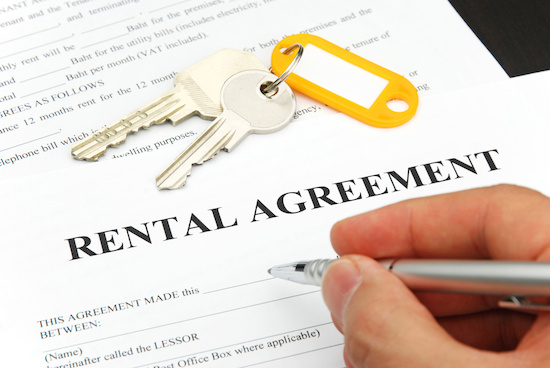What Is a Lease Agreement?


Written by Jennifer Lyons on July 30, 2025
Reviewed by Chrissy Tran
A lease agreement is a legal agreement between you (the tenant) and the landlord. It outlines the terms of renting a property, including responsibilities, expectations, and rules for both parties. This document can help clarify responsibilities and expectations for both you and your landlord.
Leases can vary in length, structure, and legal requirements depending on where you live. While this may sound overwhelming, knowing the essentials can ensure peace of mind throughout the rental experience.
Lease agreement vs. rental agreement
While the terms "lease agreement" and "rental agreement" are sometimes used interchangeably, they usually describe different types of rental contracts. Understanding the difference between lease agreements and rental agreements may help you choose an arrangement that best aligns with your lifestyle and future plans.
Lease agreement
A lease is a fixed-term contract, often lasting 6 to 12 months or more. During this time, the monthly rent is locked in, providing stability for renters who want to settle into one place for longer. Leases are less flexible, as breaking a lease may lead to penalties.
Rental agreement
A rental agreement typically refers to a month-to-month lease, which renews automatically each month unless either the tenant or landlord gives notice to end or modify the agreement. This type of arrangement offers flexibility for both the renter and landlord to terminate the agreement with proper notice (typically 30 days). This is ideal for those with short-term needs or uncertain timelines. A rental agreement is different from a short-term rental, like an Airbnb. Short-term rentals use their own contracts, not a rental agreement.
Find your perfect rental on Zillow
What is included in a lease agreement?
A lease agreement is a legally binding document that outlines the terms and conditions of your rental arrangement. It helps protect both you and your landlord by clearly defining responsibilities and expectations. Here are the key elements a lease typically includes:
Names of parties
This lists all adult members living in the residence and makes them legally responsible for maintaining the lease's terms.
- Tenant names
- Landlord name
- Property manager (if applicable)
Property details
The rental property's address, unit number (if applicable), and any included amenities, like parking or storage, should be outlined in your lease.
Lease duration
The lease duration is the length of your lease. Your lease may be three, six, nine, or 12 months long, or in some cases even longer. A standard lease will outline a beginning and ending date. Termination before the ending date is prohibited unless for a reason outlined in the lease or law. Otherwise, you will pay a penalty, which should be detailed in this section.
Rent and payment terms
This confirms the exact amount you have to pay each month. The agreement should specify the monthly rent amount, what is included in the rent cost (such as utilities like water and garbage), when rent is due, accepted payment methods, and any late fees or penalties. Check to see if online rent payments are an option.
Security deposit
Some rental arrangements will require a security deposit. If so, the required amount, conditions for deductions, and the process for refunding the security deposit at the end of the lease are typically included. However, local laws govern how a security deposit must be handled.
Responsibilities
The lease should specify your responsibilities as the tenant and your landlord’s responsibilities. This may include things like:
- Who is responsible for repairs?
- Who is responsible for upkeep?
- Who pays for utilities, like water, gas, and electricity (or are they included)?
Rules and restrictions
Rules and restrictions may vary depending on the type of arrangement. Lease agreements will typically include policies on pets, noise, guests, and alterations to the property. Some agreements have limits on, or specifically prohibit, tenants from renting to others, also known as subletting. These rules help maintain a safe, respectful, and orderly living environment for all tenants.
Occupancy limits
This may include limiting the tenancy to residential use (as opposed to it being used as a business or other commercial space) and specifying the number of people who can live in the unit. There may also be restrictions on who can stay overnight.
Termination terms
The lease should include the notice period required to end the lease and any early termination fees. This section also explains the proper procedures for moving out and any penalties for breaking the lease early.
Right of entry
The right of entry specifies when and why the landlord can enter the rental unit, such as for repairs or inspections, often with prior notice.
Process for requests
The lease should outline who to contact for maintenance or other issues, as well as the request process for tenants. Make sure this includes specific contact information and a clear statement of your responsibilities.
Always read your lease carefully, and ask your landlord questions for clarification. Understanding the details up front helps prevent misunderstandings later.
How does a lease work?
A lease is a legally binding contract between you (the tenant) and your landlord. Here's a step-by-step breakdown of how a lease agreement works:
- Agree on terms: Before signing, you'll negotiate and agree on aspects like rent price, payment schedule, lease duration, and any rules (e.g., pet policies or subletting).
- Sign the agreement: Once finalized, both parties sign the lease, securing your right to reside in the property for the agreed period as long as you adhere to the terms.
- Payment obligations: You’ll likely pay the first month’s rent and a security deposit upfront. Then, rent is typically due monthly.
A lease provides renters reassurance that their rental situation won’t unexpectedly change during the term, while giving landlords the benefit of a steady income during a fixed term.
How does a month-to-month lease work?
Month-to-month leases, sometimes referred to as rental agreements, operate similarly to fixed-term leases. The main difference is that month-to-month leases renew automatically every month, unless either party provides notice to terminate the lease (usually 30 days). Month-to-month leases work best for renters, who prioritize flexibility over long-term cost stability.
Benefits of month-to-month leases
- You can move out with minimal commitment if your circumstances change.
- Some units may come furnished.
- Flexibility to terminate the agreement or renew monthly.
Drawbacks of month-to-month leases
- Leases may come with higher rent compared to fixed-term leases.
- Landlords may increase rent or terminate the lease with appropriate notice, making them less predictable compared to fixed-term leases.
What happens if you break a lease?
Breaking a lease prematurely may lead to penalties, such as paying the remaining rent due or a flat termination fee. If these penalties go unpaid, the landlord may pursue collections or legal remedies, which could negatively impact your credit score.
If you're considering ending your lease early, check if your agreement allows subleasing, as you may be able to find someone to take over your lease. Some leases also include early termination clauses that cover specific situations, like job relocations or medical emergencies. Additionally, open communication and negotiation with your landlord can often lead to amicable solutions.
Find an apartment you’ll love on Zillow
With Zillions of up-to-date listings and filters for your must-haves, it's easy to find your perfect apartment on Zillow Rentals.
Search rentals

